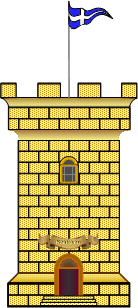Other Info
Castle Classification |
Classification and categories of Greek Castles
The Greek Castles in Kastrologos, are classified in various categories and scales. This categorization is helpful but is not used elsewhere, so some definitions are necessary:
Evaluation
The castles are evaluated using an indication with stars, in a scale from 0 to 5 stars.
| ★★★★★ | ★★★★★ | ★★★★★ | ★★★★★ | ★★★★★ | ★★★★★ |
| Low-Value | Interesting | Noteworthy | Good | Very Good | Excellent |
The evaluation is based on the following factors (in descending weight order):
• Current Condition
• Architecture
• Size
• Defensive properties
• Recognizability
• Historical background
• Accessibility
With 0 stars are evaluated castles which are in ruins to the degree that it is not obvious they have been medieval castles. Also, some monuments that may be otherwise very important but have lower value as castles (like some monasteries).
The high-rank castles are in the page with the Top Castles.
Castle Types
The Greek Castles are grouped (in our site) in various types based on certain attributes: function, layout, period, location, condition.
Some overlapping could not be avoided, but this classification for the castles in Greece makes sense.
The castles types:
Castle
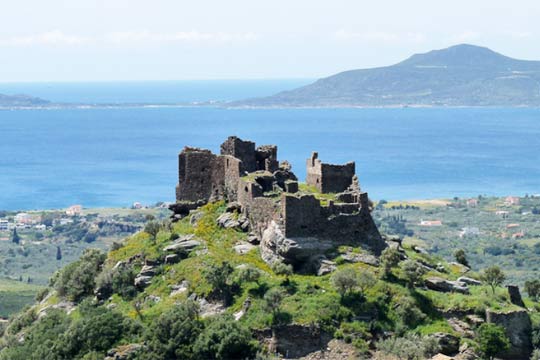 The typical medieval castles built, usually, on top of a hill in a strategic location or above towns. Sometimes -but not always- it was the residence of the local lord or included a small settlement.
The typical medieval castles built, usually, on top of a hill in a strategic location or above towns. Sometimes -but not always- it was the residence of the local lord or included a small settlement.
The term “castle” is generic but in the classification of Kastrologos this type is limited to castles built in the Middle Ages (roughly between 400 A.D. and 1500).
Most Greek Castles belong in this category.Fortress
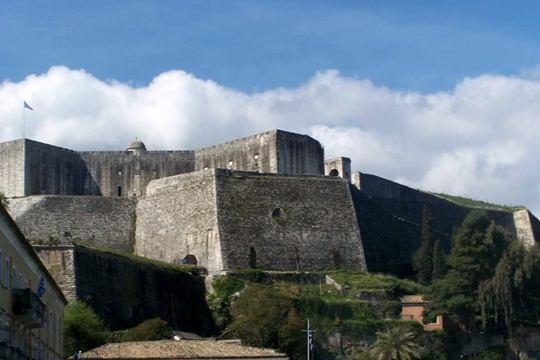 Post-medieval large forts used as base of military units without special concern for the accommodation and protection of the local population. A common characteristic is the reinforced fortification to withstand firearms.
Post-medieval large forts used as base of military units without special concern for the accommodation and protection of the local population. A common characteristic is the reinforced fortification to withstand firearms.
The term “fortress” is also generic but for the classification of the site is limited to sizable forts constructed after the 15th century.
Examples: Palamidi, New Castle of Corfu.Ancient City
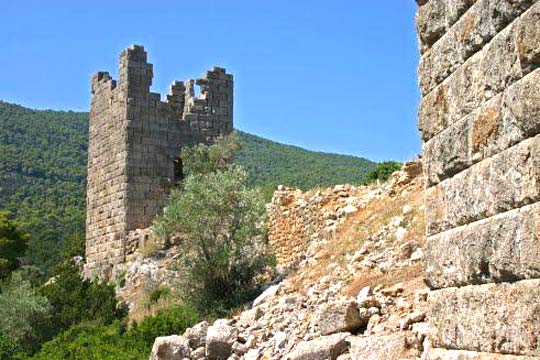 Fortifications of ancient cities that were in use until the Middle Ages with minor additions and modifications. A considerable part of their construction had been completed in premedieval times
Fortifications of ancient cities that were in use until the Middle Ages with minor additions and modifications. A considerable part of their construction had been completed in premedieval times
Examples: Aigosthena, Paravola.Fortress-State
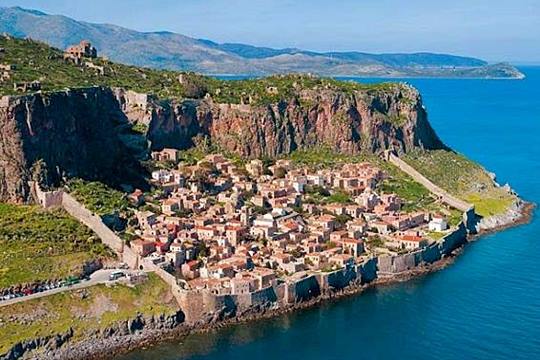 Fortified medieval cities which are now either in ruins (like Mystras) or without many modern constructions (like Monemvasia).
Fortified medieval cities which are now either in ruins (like Mystras) or without many modern constructions (like Monemvasia).
In most of them there is also a citadel.Byzantine city
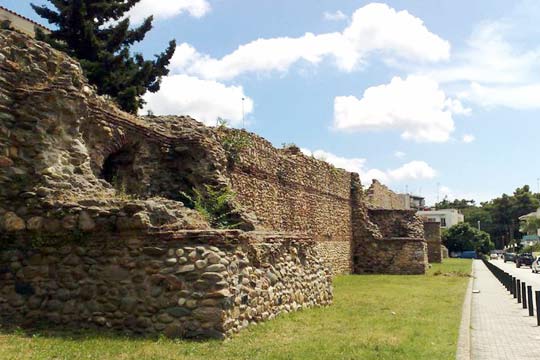 Remains of the defensive walls of a Byzantine city that cannot be categorized as Fortress-State either because of their bad condition or because they co-exist with too many modern buildings.
Remains of the defensive walls of a Byzantine city that cannot be categorized as Fortress-State either because of their bad condition or because they co-exist with too many modern buildings.
Example: Thessaloniki walls.Medieval Settlement
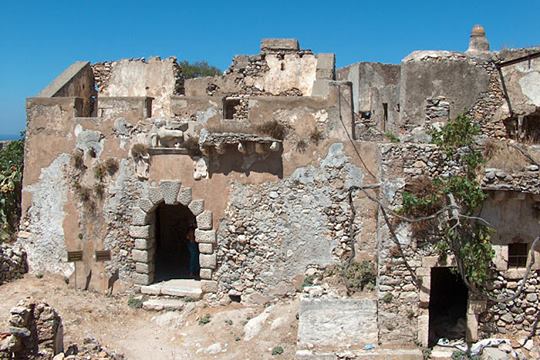 Medieval settlements with some fortification. There are many deserted medieval towns and villages in Greece, but only those with remains of their fortification are included in Kastrologos.
Medieval settlements with some fortification. There are many deserted medieval towns and villages in Greece, but only those with remains of their fortification are included in Kastrologos.
Examples: Mylopotamos, Osdina.Coastal Fortress
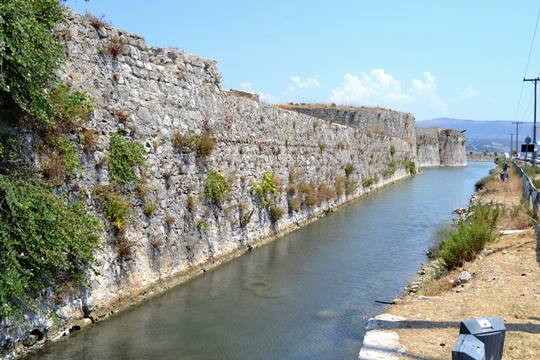 Seaside castles for the surveying of the sea traffic and the defense of coasts or ports. They could belong to previous types as well, but this class is especially for the castles that their primary function was to control the sea.
Seaside castles for the surveying of the sea traffic and the defense of coasts or ports. They could belong to previous types as well, but this class is especially for the castles that their primary function was to control the sea.
Examples: Firka Fortress, Fortress of Pantokrator.Island Citadel
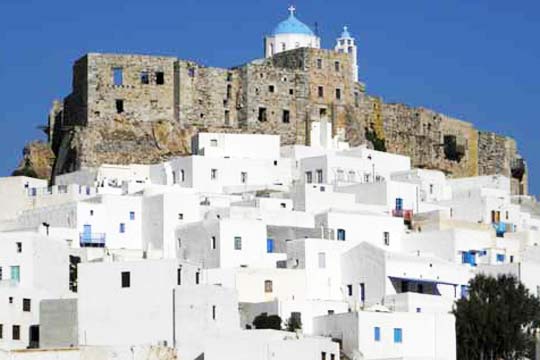 Castles in Aegean islands, primarily for the protection of the population from the pirates. Most of them became the nucleus around which an existing (and picturesque) town has been developed ("Chora"). Often the houses around the nucleus are arranged in a way that they form the external fortification.
Castles in Aegean islands, primarily for the protection of the population from the pirates. Most of them became the nucleus around which an existing (and picturesque) town has been developed ("Chora"). Often the houses around the nucleus are arranged in a way that they form the external fortification.
Examples: Astypalaia castle.Small Fort
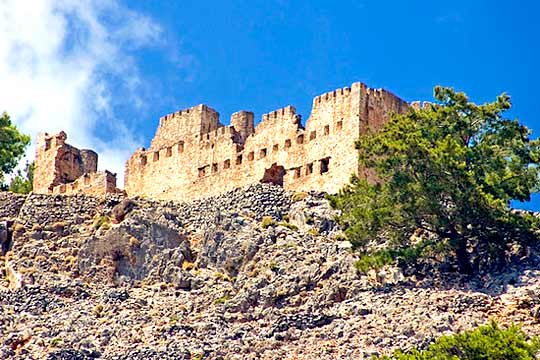 Small fortresses and forts built in the 18th and mainly in the 19th century which housed a small unit or garrison. They were designed without special concern for the accommodation and protection of the local population and they were suitable for the use (and the defense against) fire-guns.
Small fortresses and forts built in the 18th and mainly in the 19th century which housed a small unit or garrison. They were designed without special concern for the accommodation and protection of the local population and they were suitable for the use (and the defense against) fire-guns.
The most typical example is the various koule towers in Crete.Castle-monastery
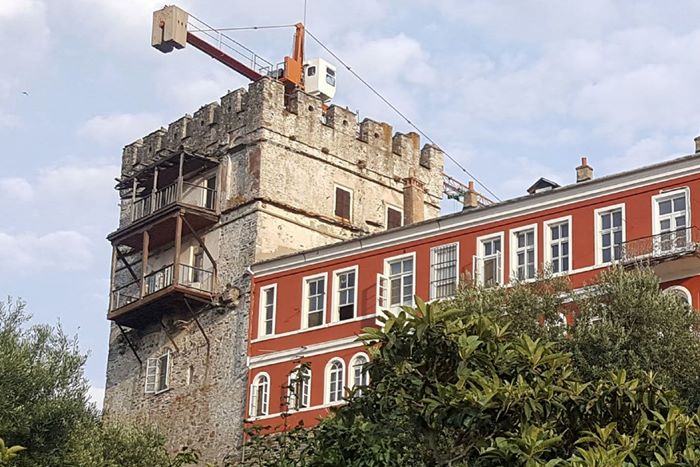 Fortified monasteries and towers in monasteries with a defensive role and characteristics.
Fortified monasteries and towers in monasteries with a defensive role and characteristics.Fortified church
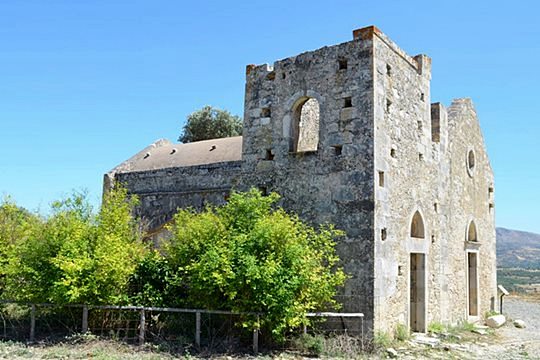 Some Byzantine and Frankish churches in Greece have some sort of Fortification. It is not accurate to be categorised as castles-monasteries. There are only 3 in Kastrologos, but we have just started to pay attention to them.
Some Byzantine and Frankish churches in Greece have some sort of Fortification. It is not accurate to be categorised as castles-monasteries. There are only 3 in Kastrologos, but we have just started to pay attention to them.
Examples: Falandra, Kosmosoteira.Cross-Wall
Fortification walls that did not enclose a protected location but closed a passage or an opening between two natural obstacles, like a fortress with only one facet.
Example: Wall of Christoupolis.Watchtowers (or Viglas)
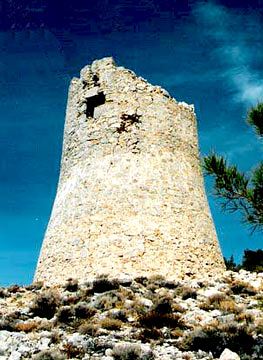 Small towers which had a defensive use, of course, but their primary role was to serve as observatories, fire signal posts and guard-posts. Under normal circumstances, their crew was maximum two men.
Small towers which had a defensive use, of course, but their primary role was to serve as observatories, fire signal posts and guard-posts. Under normal circumstances, their crew was maximum two men.
The name of this type of constructions was “vigla” (Gr. βίγλα).
The viglas in Kastrologos are all coastal and part of a defensive network to inform of pirate raids. There are towers in non-coastal areas that could be categorised as “viglas”, but these inland towers had multiple uses and were seldom used as observatories onlyTower
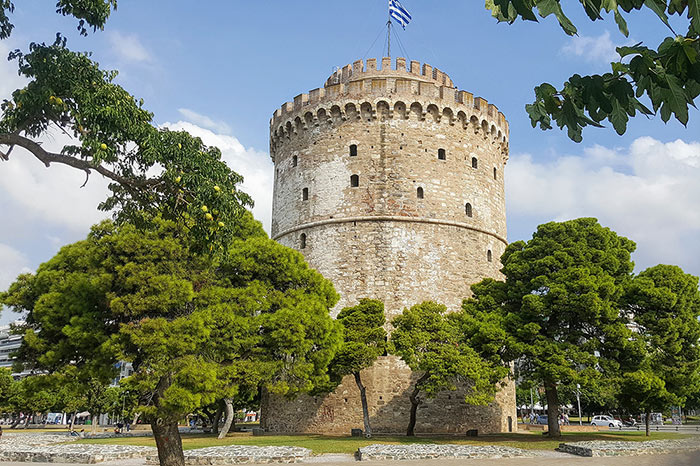 Isolated towers which are the remaining part of a larger fortification or have been independent structures used as bastions and observation towers.
Isolated towers which are the remaining part of a larger fortification or have been independent structures used as bastions and observation towers.Tower House
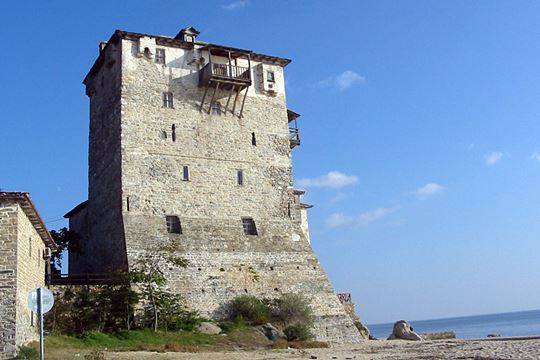 Relatively small castles and towers which have been used primarily as the residence of local lords and secondarily as fortified positions
Relatively small castles and towers which have been used primarily as the residence of local lords and secondarily as fortified positionsAncient Towers
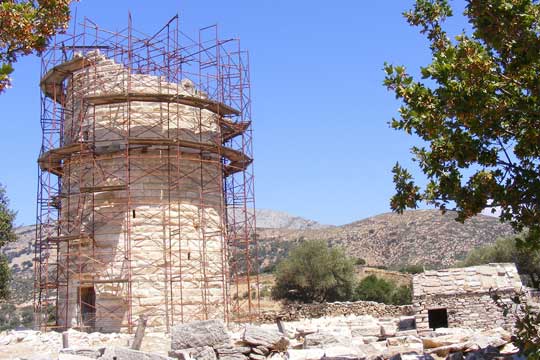 Towers built in antiquity which remained in use in Middle Ages. Few ancient towers are preserved in a good height in Greece and some of them must have been used also in the Middle Ages.
Towers built in antiquity which remained in use in Middle Ages. Few ancient towers are preserved in a good height in Greece and some of them must have been used also in the Middle Ages.
Example: Cheimaros tower.Castle Cave
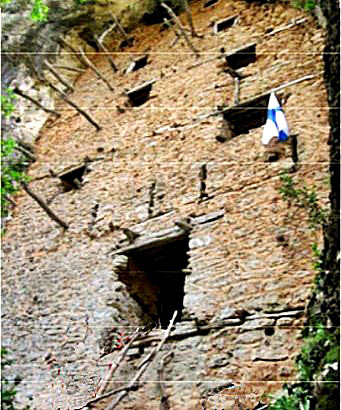 Caves and rock cavities with big openings that were fortified to be used as dens or refuges.
Caves and rock cavities with big openings that were fortified to be used as dens or refuges.
Example: Cave castle of Tourkopanagis.Castle Ruins
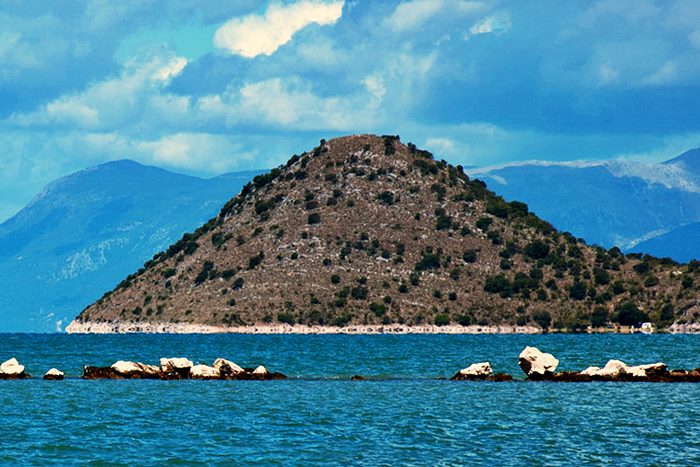 Almost all castles in Greece are ruined to some degree, but in this category are included castles with only rubble and piles of stones or a few remains barely visible, with only traces to denote that this was actually a castle.
Almost all castles in Greece are ruined to some degree, but in this category are included castles with only rubble and piles of stones or a few remains barely visible, with only traces to denote that this was actually a castle.
Example: Mouchli Castle.Ruined Towers
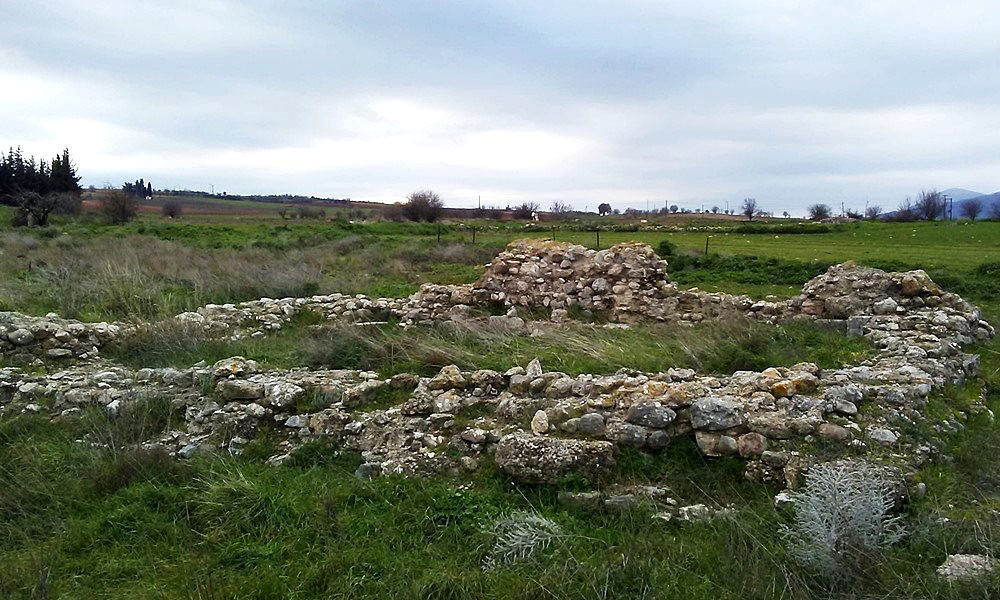 Remains of medieval towers that do not look like towers at all being severely damaged and destroyed.
Remains of medieval towers that do not look like towers at all being severely damaged and destroyed.
Example: Aspropyrgos Tower.Drystone fortifications
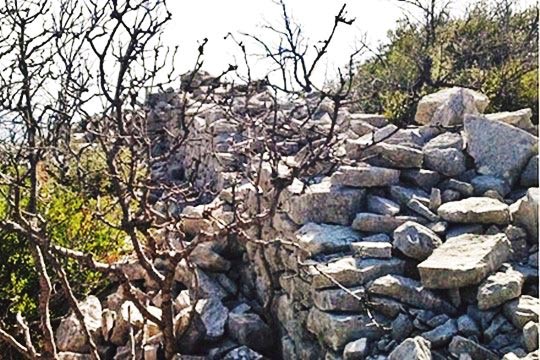 Low quality fortifications made of semi-processed stones without mortar, often of uncertain chronology.
Low quality fortifications made of semi-processed stones without mortar, often of uncertain chronology.
Example: Gyclos castle.Natural Forts
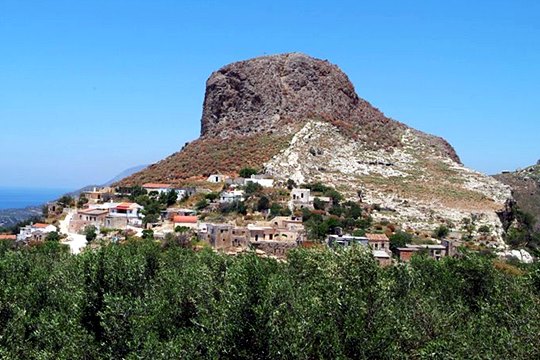 Locations protected in a natural way by the rough terrain (steep rock, high elevation) that were used by locals mainly as refuges with minimum construction of fortifications
Locations protected in a natural way by the rough terrain (steep rock, high elevation) that were used by locals mainly as refuges with minimum construction of fortifications
Example: Petrota castle.
Historic Origin
The castles in the site are classified by historic origin which is defined by the nationality of the rulers of the castle in the period that the castle was built or the period that it was reconstructed and took the form that more or less is preserved until today.

Ancient
Castles built before the 3rd century AD which have been used also in the Middle Ages without major modifications.
Early-Byzantine
Castles built or reconstructed by the Byzantines during the 4th and 5th centuries without major modifications in the following centuries.
Byzantine
Castles built or reconstructed by the Byzantines between the 6th and 12th century (an alternative term could have been "Middle-Byzantine").
Late-Byzantine
Castles built or reconstructed by the Byzantines or the various Greek Despotates during the 13th, 14th or 15th century.
Frankish
Castles built or reconstructed by the "Franks" (or "Latin") conquerors after the fall of Constantinople in 1204, during the 13th and the 14th centuries, mostly.
Venetian
Castles built or reconstructed by the Venetians during the various periods of the Venetian occupation, between the 13th and the 17th century.
Ioannite
Castles built or reconstructed by the Knights of the Order of Saint John of Rhodes in Dodecanese during the 14th century.
Genoan
Castles built or reconstructed by the Genoans, mainly in North Aegean and mostly during the 14th century.
Catalan
Castles built by the Catalans of the Catalan Company (who later became the masters of the Duchy of Athens) during the 14th century in Evia and in Sterea Hellas (central Greece between Attica and Thessaly)Post-Byzantine
Fortifications built after the fall of Constantinople from the 15th to the 17th century by Greeks.
In this site the term refers exclusively to fortifications in monasteries.Ottoman
Castles built or reconstructed by the Turks from the end of the 15th until the 19th century.Modern Greek
Fortified buildings constructed by Greek warlords in the last period of the Turkish occupation.
Geographical Distribution
The castles are distributed geographically by Municipality, Prefecture and Region .
For the Municipalities, we follow the recent (2010) partition of Greece in 325 municipal authorities according to the program "Kallicrates". We must point out that the term "municipality" nowadays is much wider than the “city”. For instance, the whole island of Rhodes is one municipality.
The castles are also distributed by prefectures (or counties). This partition is officially obsolete but geographically useful.
For the distribution by regions, we follow the official segmentation of Greece in 13 administrative regions (or peripheries, 1986): Attica, Central Greece, Central Macedonia, Crete, East Macedonia & Thrace, Epirus, Ionian Islands, North Aegean, Peloponnese, South Aegean, Thessaly, West Greece, West Macedonia. The monastery community of Mount Athos is considered also as an additional periphery.
Random choice from the top Greek Castles



